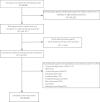Association of physical activity pattern and risk of Parkinson's disease
- PMID: 38783073
- PMCID: PMC11116521
- DOI: 10.1038/s41746-024-01135-3
Association of physical activity pattern and risk of Parkinson's disease
Abstract
Increasing evidence suggests an association between exercise duration and Parkinson's disease. However, no high-quality prospective evidence exists confirming whether differences exist between the two modes of exercise, weekend warrior and equal distribution of exercise duration, and Parkinson's risk. Hence, this study aimed to explore the association between different exercise patterns and Parkinson's risk using exercise data from the UK Biobank. The study analyzed data from 89,400 UK Biobank participants without Parkinson's disease. Exercise data were collected using the Axivity AX3 wrist-worn triaxial accelerometer. Participants were categorized into three groups: inactive, regularly active, and engaged in the weekend warrior (WW) pattern. The relationship between these exercise patterns and Parkinson's risk was assessed using a multifactorial Cox model. During a mean follow-up of 12.32 years, 329 individuals developed Parkinson's disease. In a multifactorial Cox model, using the World Health Organization-recommended threshold of 150 min of moderate-to-vigorous physical activity per week, both the active WW group [hazard ratio (HR) = 0.58; 95% confidence interval (CI) = 0.43-0.78; P < 0.001] and the active regular group (HR = 0.44; 95% CI = 0.34-0.57; P < 0.001) exhibited a lower risk of developing Parkinson's disease compared with the inactive group. Further, no statistically significant difference was observed between the active WW and the active regular groups (HR = 0.77; 95% CI = 0.56-1.05; P = 0.099). In conclusion, in this cohort study, both the WW exercise pattern and an equal distribution of exercise hours were equally effective in reducing Parkinson's risk.
© 2024. The Author(s).
Conflict of interest statement
The authors declare no competing interests.
Figures



References
LinkOut - more resources
Full Text Sources

